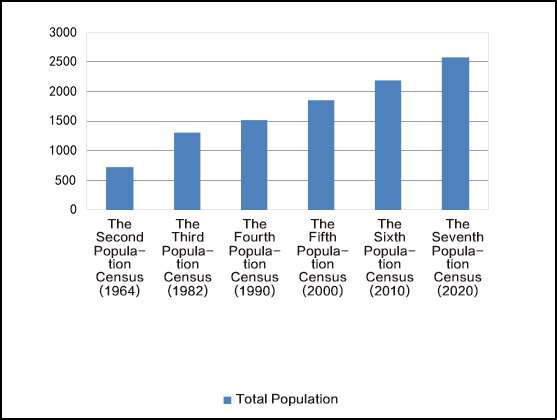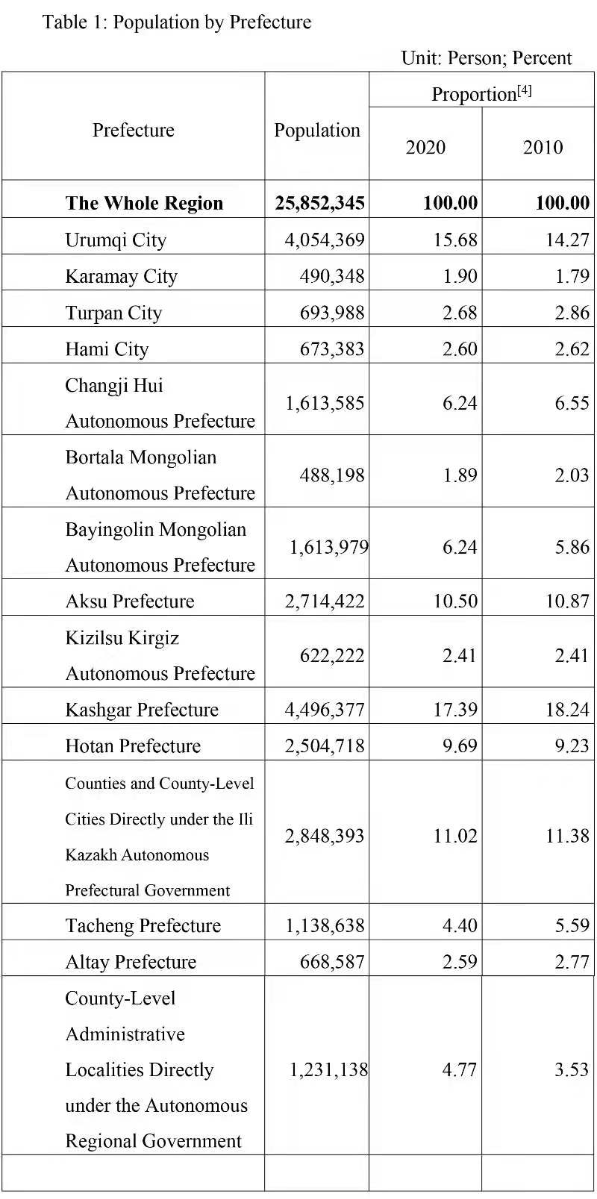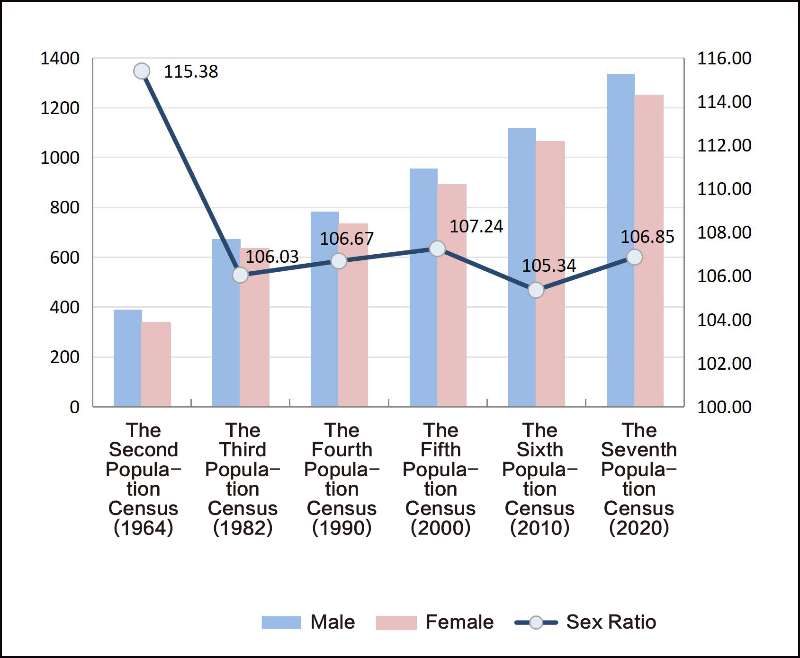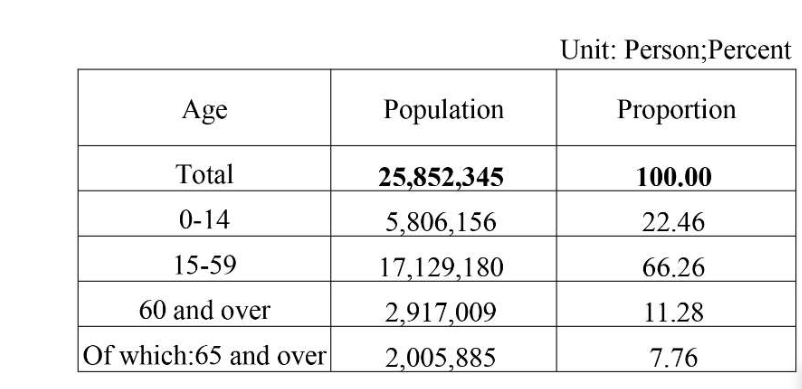Main Data[1] of Xinjiang Uygur Autonomous Region
from the Seventh National Population Census
Statistics Bureau of Xinjiang Uygur Autonomous Region
&
Office of the Leading Group of Xinjiang Uygur Autonomous Region for the Seventh National Population Census
June 14, 2021
Under the strong leadership of the Central Committee of the Communist Party of China (CPC), according to the coordinated decisions and arrangements made by the Leading Group of the State Council for the Seventh National Population Census (hereinafter referred to as the Census), Xinjiang has completed the field enumeration and the aggregation of the main data successfully with the meticulous organization of the autonomous regional leading group of the Census, cooperative advancement of all prefectures, cities and concerned government departments, the joint and active participation of the census respondents as well as the concerted efforts and dedications of the 137,000 census staff in the region. Released as follows are the basic introduction and main data of the Census in Xinjiang.
I. Basic Introduction
In accordance with the Statistics Law of the People's Republic of China and the Regulations on National Population Census, Xinjiang carried out its work of the Census with 00:00 hours of November 1, 2020 as the reference time. The Census offers a comprehensive understanding of the number, structure, distribution and other aspects of Xinjiang’s population, as well as the trending changes of the population growth, floating population, and education level of the population. It provides accurate statistical information support for the improvement of Xinjiang's population development strategy and policy, the formulation of economic and social development plans and the advancement of high quality development.
The CPC committee and government of Xinjiang attached great importance to the Census. A total of 1,529 census agencies were set up, and 137,000 census staff were selected to join the work. Census agencies at all levels and all census staff made active efforts to overcome the impact of the COVID-19 pandemic and successfully completed the field enumeration of all households and residents in Xinjiang.
In the Census, data were collected on site and reported directly in real time by fully adopting digital data collection for the first time, thus minimizing errors in the intermediate links. The application of administrative records and big data from electricity meters and mobile phones was also strengthened. As a result, the quality and efficiency of the Census were improved. The publicity about the Census was intensified in various ways. Its slogan“Population Census, Everyone Counts” resonated powerfully with the people. Xinjiang conducted the Census in accordance with the law, implemented all requirements of the census program and the quality control system, and efficiently completed the comparison and review of the census data.It ensured the census materials supply and standardized the subsidy distribution to census staff. The State Council Population Census Office dispatched spot check teams to conduct post enumeration survey in eight census communities of four counties (cities and districts) randomly selected across the autonomous region. Xinjiang’s data quality has been fully affirmed by the spot check teams.
II. Main Data of the Census
According to the results of the Census, released as follows are the main data of the permanent population[2] in Xinjiang at00:00 hours of November 1, 2020:
1. Population of Xinjiang
(1)Total Population. According to the results of the Census, the total population[3] in Xinjiang at 00:00 hours of November 1, 2020 was 25,852,345 persons. Among all the 31 provinces, autonomous regions and municipalities in China, Xinjiang climbed from the 25th in the Sixth National Population Census in 2010 to the current 21st in terms of ranking of permanent population.
(2) Population Growth. Compared with the population of 21,813,334 persons in 2010 (data of the Sixth National Population Census), Xinjiang’s permanent population increased by 4,039,011 persons, or 18.52 percent, and the average annual growth rate was1.71percent, respectively 13.14 percentage points and 1.18 percentage points higher than the national average. The data shows that with the socioeconomic development and unleashing of stability dividends in recent years, Xinjiang has attracted large amount of people to invest and start business, thus promoting steady growth of the population.
Figure 1: Xinjiang’s Total Population of Each Census
Unit: 10,000 persons

(3) Population of Ethnic Groups.Among Xinjiang’s permanent population, the population of the Han ethnic group was 10,920,098 persons, accounting for 42.24 percent; that of the ethnic minorities was14,932,247 persons, accounting for 57.76 percent. Of the ethnic minority population, the population of the Uygur ethnic group was 11,624,257 persons, accounting for 44.96 percent of the autonomous regional total population and 77.85 percent of its ethnic minority population. Compared with 2010, the ethnic minority population in Xinjiang increased by 1,865,061 persons, up by 14.27 percent, which was 4.01 percentage points higher than the national ethnic minority population growth rate of 10.26 percent. The steady growth of Xinjiang’s population of all ethnicities fully reflected the comprehensive development and progress of all ethnic groups under the leadership of the CPC.
Compared with the data of the Sixth National Population Census, Xinjiang’s total population in the latest Census increased by 4.039 million persons. The population of the Han ethnic group increased by 2.174 million persons, including 1.948 million persons who migrated from other provinces. The Uygur population increased by 1.623 million persons, up 16.2 percent.
2. Population of Prefectures and Cities
Among the 14 prefectures and cities in Xinjiang, there were five with a population of more than two million, three with a population of between one million to two million, four with a population of between 500,000 to one million, and two with a population of less than 500,000. The data about permanent population of the 14 prefectures and cities at 00:00 hours of November 1, 2020 are as follows:

3. Sex Composition of the Permanent Population.
Of the permanent population in Xinjiang, 13,354,380 persons or 51.66 percent were males while 12,497,965 persons or 48.34 percent were females. The sex ratio (female=100, male to female) was 106.85.
Figure 2: Sex Composition of Xinjiang’s Population in Each Census

4. Age Composition.
Of the permanent population, there were 5,806,156 persons in the age group of 0 to 14[5], accounting for 22.46 percent; 17,129,180 persons in the age group of 15 to 59, accounting for 66.26 percent; 2,917,009 persons in the age group of 60 and over, accounting for 11.28 percent, including 2,005,885 persons in the age group of 65 and over, accounting for 7.76 percent.
Table 2: Age Composition of the Permanent Population in Xinjiang

In Xinjiang, the share of children in the age group of 0 to 14 was 4.51 percentage points higher than the national average of 17.95 percent; that of people in the working age group of 15 to 59 was 2.91 percentage points higher than the national average of 63.35 percent; that of the elderly in the age group of 60 and over was 7.42 percentage points lower than the national average of 18.7 percent, showing a lower degree of aging.
5.The Population’s Education.
(1) Educational Attainment. Of the permanent population in Xinjiang, there were4,274,826persons with university education (junior college and above); 3,414,458 persons with senior middle school (or technical secondary school) education; 8,158,620 persons with junior middle school education; 7,343,482 persons with primary school education (The above population with different educational levels includes graduates, drop-outs and current students in various schools). Compared with 2010, for every 100,000 persons, the number of people with university education increased from 10,635 persons to 16,536 persons; those with senior middle school education increased from 11,582 persons to 13,208 persons; those with junior middle school education decreased from 36,096 persons to 31,559 persons; those with primary school education decreased from 30,075 persons to 28,405 persons.
(2) Average Years of Schooling[6]. The average years of schooling for people aged 15 and above increased from 9.27 years to 10.11 years.
Among the population with educational attainment, for every 100,000 persons, the number of people with university education was 1,069 more than the national average. The average years of schooling for people aged 15 and above is 0.2 year higher than the national average of 9.91 years, ranking Xinjiang the 10th among the 31 provinces, autonomous regions and cities. The illiteracy rate[7]in Xinjiang was 2.66 percent, 0.01 percentage point lower than the national average. The continued improvement of the educational attainment demonstrated Xinjiang’s achievements in promoting various education and raising the population quality through hard efforts over the past ten years.
6. Urban and Rural Population and Floating Population.
(1)Urban and Rural[8] Population. Of the permanent population in Xinjiang, there were 14,613,622 persons living in urban areas, accounting for 56.53 percent; 11,238,723 persons living in rural areas, accounting for 43.47 percent. Compared with 2010,the urban population increased by 5,277,870 persons, and the rural population decreased by 1,241,340 persons. The share of urban population went up by 13.73 percentage points.With the in-depth development of China’s new industrialization, informatization and agricultural modernization, Xinjiang’s new urbanization has been advanced steadily and the urbanization construction has scored historical achievements over the past ten years.
(2) Floating Population.The floating population in Xinjiang numbered 8,051,404 persons. Of them, the population moving into Xinjiang from other provinces reached 3,390,712 persons, and those moving within Xinjiang reached 4,660,692 persons. In recent years, the sustained social stability and economic development have facilitated the population migration and mobility, the trends of which have become increasingly evident, and the size of floating population has further grown.
Xinjiang’s work of the Seventh National Population Census has offered a good understanding of the size, structure and distribution of the autonomous region's population, mapped accurately the trends of the demographic changes, and provided abundant and valuable information. We will work hard to compile, analyze and develop the census data, and collaborate with relevant departments to strengthen the forward-looking and strategic study on population development. All these efforts will make full use of the census and provide strong statistical information support to advance Xinjiang’s long-term, high-quality and balanced population development.
Notes:
[1] In this release, all figures are preliminary summary results. The discrepancies between the total of some indicators and the itemized ones are mainly results of rounding. No mechanical adjustment has been made.
[2] Permanent population includes people living in the current town/street where their household registration is located or with their household registration to be settled; people living in the current town/street and leaving the town/street of their household registration for over 6 months; people leaving the town/street of their household registration for less than 6 months or working or studying overseas, with their household registration located in the current town/street.
[3] The total population in Xinjiang refers to the permanent population of the 14prefectures,cities and county-level cities directly under the autonomous regional government, excluding residents of Hong Kong, Macao and Taiwan and foreigners living in the14prefectures,cities and county-level cities.
[4] It refers to the proportion of permanent population of each prefecture or city in that of the autonomous region.
[5] The people in the age group of 0 to 15 numbered 6,118,388, and those in the age group of 16 to 59 numbered 16,816,948.
[6] The average years of schooling are means of schooling years converted from the duration of each level of education. Specifically, primary school=6 years; junior middle school=9 years; senior high school=12 years; and junior college and above=16 years.
[7] The illiteracy rate refers to the population of people aged 15 and above who cannot read divided by the autonomous regional permanent population.
[8] Urban and rural areas are classified based on the Regulations on Classification of Urban and Rural Areas for Statistics issued by the National Bureau of Statistics of China.
(In case of any difference between English translation and the original Chinese text, the Chinese edition shall prevail.)




